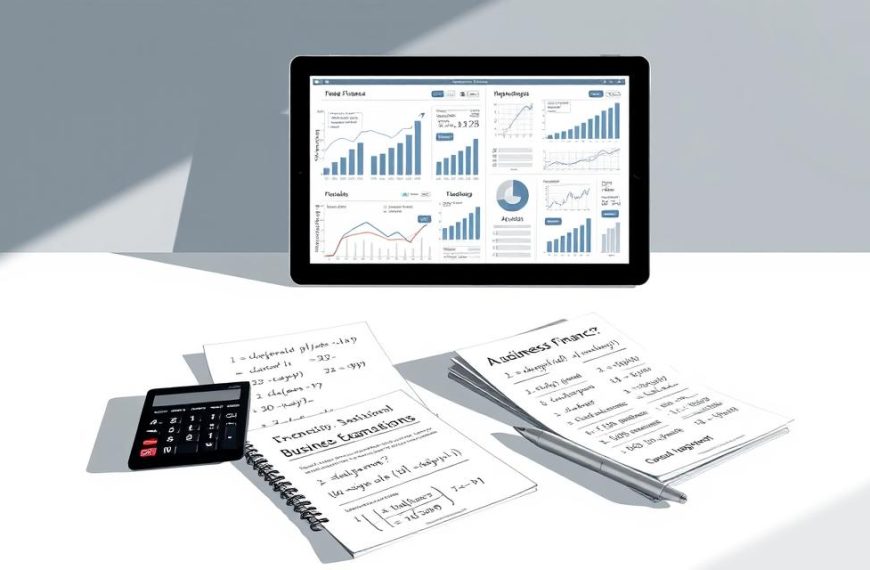Mathematics serves as the backbone of modern finance and business operations, providing the analytical framework necessary for informed decision-making.
The integration of mathematical principles into business practices has evolved significantly, from basic accounting calculations to sophisticated financial modelling and risk assessment techniques.
In today’s data-driven business environment, mathematical literacy has become an essential skill for professionals across all sectors of finance and business management.
The Fundamental Relationship Between Mathematics and Business
Mathematics plays a crucial role in the business world, enabling companies to optimise their operations and strategic planning. The relationship between mathematics and business is deeply intertwined, with mathematical concepts providing the foundation for informed decision-making.
What is Business Mathematics?
Business mathematics encompasses the application of mathematical principles to solve commercial problems and optimise business operations. It provides the quantitative foundation for financial analysis, resource allocation, and strategic decision-making. Business mathematics is essential for companies to analyse data, forecast trends, and make informed decisions.
Why Mathematical Skills Matter in Modern Business
In modern business environments, mathematical competency has become a differentiating factor for professionals seeking advancement in finance, marketing, operations, and management roles. Mathematical skills enable business professionals to interpret data patterns, forecast trends, and develop evidence-based strategies. The table below highlights key areas where mathematical skills are crucial.
| Business Area | Mathematical Application | Benefit |
|---|---|---|
| Finance | Financial modelling, forecasting | Improved financial planning |
| Marketing | Data analysis, trend forecasting | Enhanced marketing strategies |
| Operations | Resource allocation, optimisation | Increased operational efficiency |
Essential Mathematical Concepts in Finance and Business
Mathematical concepts are fundamental to the success of businesses and financial institutions, providing a framework for analysis and optimisation. The use of mathematical techniques enables businesses to make informed decisions, assess risks, and drive strategic planning.
Algebra and Arithmetic in Business Operations
Algebra and arithmetic are crucial in business operations, enabling professionals to solve equations, calculate financial ratios, and perform break-even analyses. For instance, business mathematics involves using algebraic methods to project revenues and expenses, as well as conducting basic computations like interest expenses.
Statistics and Probability for Business Analysis
Statistical concepts like mean, median, and standard deviation help businesses interpret data patterns and make evidence-based forecasts. Probability theory enables risk assessment and decision-making under uncertainty, allowing businesses to quantify the likelihood of various outcomes.
Calculus and Its Business Applications
Calculus provides tools for optimisation problems in business, helping to maximise profits, minimise costs, and determine optimal pricing strategies. By understanding rates of change, businesses can analyse and maximise key metrics like profits, cost control, and revenue growth.
| Mathematical Concept | Business Application |
|---|---|
| Algebra | Financial ratio calculation, break-even analysis |
| Statistics | Data analysis, forecasting |
| Calculus | Optimisation, pricing strategies |
How is Mathematics Used in Finance and Business: Core Applications
Mathematics plays a crucial role in finance and business, driving key applications that shape industry practices. The use of mathematical techniques enables professionals to make informed decisions, analyze complex data, and predict future trends.
Financial Calculations and Reporting
Financial calculations form the backbone of business operations. Accurate reporting, budgeting, and financial statement preparation are crucial for strategic decision-making. Businesses rely on mathematical formulas to calculate profits, losses, and other financial metrics.
Business Modeling and Forecasting
Mathematical formulas and algorithms power business modeling systems. These systems simulate market conditions, project future performance, and evaluate potential business scenarios. By using mathematical models, businesses can make informed decisions about investments and resource allocation.
Data Visualisation and Statistical Analysis
Data visualisation techniques transform complex numerical information into accessible charts and graphs. Statistical analysis methods help businesses identify correlations, causations, and anomalies in market data and customer behavior.
| Mathematical Application | Description | Business Benefit |
|---|---|---|
| Financial Calculations | Accurate financial reporting and budgeting | Informed decision-making |
| Business Modeling | Simulation of market conditions and forecasting | Strategic planning and risk assessment |
| Data Visualisation | Transformation of complex data into accessible formats | Improved understanding of market trends and customer behavior |
Mathematics in Investment Banking and Financial Analysis
Mathematics plays a crucial role in investment banking, particularly in financial analysis and investment valuation. The application of mathematical models enables investment bankers to assess the viability of potential investments, mergers, and acquisitions. This involves complex calculations to determine the present value of future cash flows, taking into account the time value of money.
Discounted Cash Flow (DCF) Analysis
Discounted Cash Flow (DCF) analysis is a valuation technique used to estimate the value of an investment based on its future cash flows. By applying the time value of money concept, DCF analysis determines the present value of projected future cash flows, forming the foundation of investment valuation. This method is crucial in investment banking for evaluating potential investments and comparing different investment opportunities.
Return Metrics: NPV and IRR Calculations
Return metrics such as Net Present Value (NPV) and Internal Rate of Return (IRR) are essential in investment analysis. NPV calculations quantify the potential profitability of investments by comparing the present value of expected cash inflows against required capital outlays. IRR computations determine the discount rate at which an investment’s NPV equals zero, providing a standardised metric for comparing investment opportunities. These mathematical techniques enable investment bankers to provide evidence-based recommendations to clients and develop optimal capital structure strategies.
The use of these mathematical models has become increasingly sophisticated, incorporating probability models and scenario analysis to account for market uncertainties. As a result, investment bankers can better assess potential risks and rewards associated with different investment opportunities, ultimately making more informed decisions.
Mathematical Applications in Risk Management
In the complex world of finance, mathematical applications play a vital role in managing risk. Businesses use various mathematical tools to check for financial risks and future changes, enabling them to make informed decisions.
These mathematical risk management techniques provide systematic approaches to identify, quantify, and mitigate potential threats to financial stability and operational continuity.
Quantitative Risk Assessment Techniques
Quantitative risk assessment models use probability distributions and statistical analysis to measure the likelihood and potential impact of various risk events. For instance, Value at Risk (VaR) calculations help financial institutions determine the maximum potential loss within a specified confidence interval.
Scenario Analysis and Stress Testing
Scenario analysis applies mathematical modelling to simulate the effects of various market conditions and stress events on business performance and financial stability. Additionally, Monte Carlo simulations generate thousands of potential outcomes based on probability distributions, enabling businesses to understand the range of possible results from strategic decisions.
These mathematical applications in risk management have become increasingly important in a business environment characterised by volatility, uncertainty, and regulatory scrutiny.
Mathematics in Marketing and Pricing Strategies
In the modern business landscape, mathematical analysis is pivotal in developing marketing and pricing strategies that are both competitive and profitable. Companies utilise various mathematical models to enhance their market positioning and financial performance.
Pricing Models and Optimisation
Mathematical pricing models help businesses determine optimal price points that maximise revenue while remaining competitive in the market. Price elasticity calculations enable companies to predict how demand will respond to price changes, informing strategic pricing decisions.
Marketing Analytics and ROI Measurement
Marketing mix modelling uses regression analysis to quantify the impact of various marketing channels and activities on sales performance, optimising budget allocation. Return on investment (ROI) measurements for marketing initiatives rely on mathematical formulas that compare campaign costs against generated revenue and profit contributions.
| Marketing Channel | ROI (%) | Sales Contribution (£) |
|---|---|---|
| Social Media | 150 | 100,000 |
| Email Marketing | 200 | 80,000 |
| Influencer Marketing | 120 | 70,000 |
These mathematical applications in marketing and pricing have transformed these functions from creative-driven disciplines to data-driven strategic activities that directly contribute to business profitability.
Advanced Mathematical Applications: Quantitative Analysis
Quantitative analysis represents a sophisticated application of mathematical concepts in finance, employing advanced techniques to develop trading strategies and investment models.
The application of linear algebra is critical in portfolio management, enabling the analysis of correlations between assets and the construction of diversified portfolios. Tools such as matrices and eigenvectors help in understanding these correlations.
Linear Algebra in Portfolio Management
Linear algebra provides the mathematical foundation for modern portfolio theory. It aids in analysing how specific market factors influence asset returns, thereby optimising portfolio performance.
Stochastic Processes and Options Pricing
Stochastic processes, particularly Brownian motion models, form the basis for options pricing models like the Black-Scholes equation. These models revolutionise derivatives markets by providing a mathematical framework for predicting price movements.
Mathematical Tools and Software for Business Professionals
The advent of sophisticated mathematical tools and software has revolutionised the way business professionals operate, making complex calculations more manageable. These tools have become essential for businesses to make informed decisions and optimise resource allocation.
Excel and Spreadsheet Applications
Spreadsheet applications like Microsoft Excel provide accessible platforms for financial modelling, data analysis, and business planning without requiring advanced programming skills. Built-in financial functions enable professionals to perform complex calculations like NPV, IRR, and loan amortisation with minimal manual computation.
Specialised Financial and Statistical Software
Specialised financial software packages offer sophisticated modelling capabilities for investment analysis, portfolio management, and risk assessment. Statistical analysis tools like SPSS, SAS, and R enable businesses to perform advanced data analysis, predictive modelling, and hypothesis testing to support evidence-based decision-making.
| Software | Primary Use | Key Features |
|---|---|---|
| Microsoft Excel | Financial Modelling, Data Analysis | Built-in financial functions, Pivot tables |
| SPSS | Statistical Analysis | Data visualisation, Predictive analytics |
| SAS | Advanced Analytics | Data management, Predictive modelling |
Conclusion: The Future of Mathematics in Business and Finance
In today’s fast-paced financial and business environments, mathematical applications are revolutionizing decision-making processes. The relationship between business and mathematics has deepened as markets have become more complex and competitive, requiring increasingly sophisticated analytical approaches.
The integration of mathematics in business and finance continues to deepen, driven by emerging technologies that create new applications and opportunities for quantitative analysis. Artificial intelligence and machine learning algorithms, built on mathematical foundations, are transforming how businesses analyse data, forecast trends, and make strategic decisions at this time.
As we look to the future, it’s clear that mathematics will play an even more critical role in shaping business and finance careers. The growing complexity of global markets and financial systems increases the premium on mathematical skills, particularly in risk management and investment analysis. Professionals who develop strong mathematical foundations will be well-positioned for success in their career at this time, adapting to new trends and technologies.

















